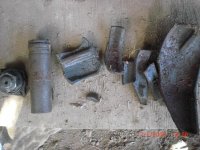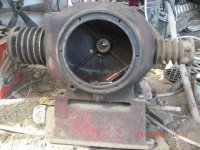I hope nobody was holding his breath, waiting for the rest of the story on my USAC compressor.
It's apart. First took off the pipes. 5/8 copper tubing from the uppercorner of the crankcase to the LP inlet, ¾ copper from LP outlet toHP inlet, 1/2” copper from HP outlet to a manifold cast in thebase. Inverted-flare fittings.
Four3/8-24 studs securing each head cameout without trouble (except that it was the studs that came outinstead of the nuts coming off) The HP side valve plugs were toughto get out, but the only thing that got broken was an easy-to-replacebrass 3/8 pipe x 1/2” inverted flare street elbow. Four identicalbrass disc valves. The LP ones needed lapping.
Heads off dislosed some rusty sludge in LP cylinder, rust streaks in HP..donot know if there is serious actual pitting yet.
Crankcasecover/bearing plate off revealed why I found it at the scrapyard.
The LP piston isdriven by an ordinary-looking connecting rod from an ordinary lookingsingle-throw forged steel crank, with two oil-splashers attached to itwith roundhead screws.
Piston is long,2x D or more. Skirt is round, not cut away, with a heavy internalrib around it, and the pin bosses extend all the way to the bottom ofthe skirt, They are tapped 3/8-16, for two hex head capscrews thatsecure to it a...”yoke” I guess you could call it.
The “yoke”is a hollow casting, through which the con-rod passes, and that alsothat goes around the big-end and crank-throw, all the way to theother side of the crankcase, where it has a 7/8” hole coaxial withthe LP piston seat. Through that 7/8 hole passes the turned-down and7/8-14 threaded end of the HP piston, which is secured with ajam-nut.
This descriptionis incomplete, because it failed to mention that the yoke lay in manypieces in the bottom of the crankcase. The threaded end of the HPpiston was still in a piece of the yoke, but had broken off thepiston, which itself lay in the bottom of the crankase. With a bigmouse-nest and the mummified remains of its owner.
Not sure if Iwill weld the yoke back together, or fabricate a new, steel one. Either way I will have to figure out how to get the two oppositepiston-mounting features precisely coaxial. Need to make one plainand one Napier-style piston-ring for the HP piston.
Oddly, the 7/8-14 nut, and both con-rod bolts were loose. Did someone have it apart and fail to tighten things, and was that the cause of the failure?
Bearings look





like babbitt, and along with the journals look in perfect shape.














